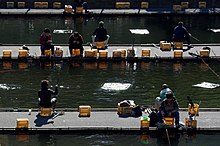
Teochew cuisine, also known as Chiuchow cuisine, Chaozhou cuisine or Teo-swa cuisine, originated from the Chaoshan region in the eastern part of China's Guangdong Province, which includes the cities of Chaozhou, Shantou and Jieyang. Teochew cuisine bears more similarities to that of Fujian cuisine, particularly Southern Min cuisine, due to the similarity of Teochew's and Fujian's culture, language, and their geographic proximity to each other. However, Teochew cuisine is also influenced by Cantonese cuisine in its style and technique.

Macrobrachium rosenbergii, also known as the giant river prawn or giant freshwater prawn, is a commercially important species of palaemonid freshwater prawn. It is found throughout the tropical and subtropical areas of the Indo-Pacific region, from India to Southeast Asia and Northern Australia. The giant freshwater prawn has also been introduced to parts of Africa, Thailand, China, Japan, New Zealand, the Americas, and the Caribbean. It is one of the biggest freshwater prawns in the world, and is widely cultivated in several countries for food. While M. rosenbergii is considered a freshwater species, the larval stage of the animal depends on brackish water. Once the individual shrimp has grown beyond the planktonic stage and becomes a juvenile, it lives entirely in fresh water.

Maki Horikita is a Japanese former actress. During her career from 2003 until 2017, she starred in numerous Japanese television dramas, television and magazine advertisements, and movies, including roles in Nobuta wo Produce, Hanazakari no Kimitachi e and Umechan Sensei.

Itoi Shigesato no Bass Tsuri No. 1 is a fishing video game developed and released only in Japan for the Super Famicom on February 21, 1997 and updated for broadcast as eight different episodes on the Satellaview subsystem between April and November 1997. On March 31, 2000, the latest version of the game was released for the Nintendo 64 as the Definitive Edition (糸井重里のバス釣りNo.1決定版!). The game allows the player to play as the creator of the game, Shigesato Itoi, and includes a host of animal characters who occasionally appear in the game. The SA-1 was used in the Super Famicom version.

Acetes is a genus of small shrimp that resemble krill, which is native to the western and central Indo-Pacific, the Atlantic coast of the Americas, Pacific coast of South America and inland waters of South America. Although most are from marine or estuarine habitats, the South American A. paraguayensis is a fresh water species. Several of its species are important for the production of shrimp paste in Southeast Asia, including A. japonicus, which is the world's most heavily fished species of wild shrimp or prawn in terms of total tonnage and represent the majority of non-human animals killed for food in terms of number of individuals.

Fishing Master is a fishing video game for the Nintendo's Wii console that was released on September 18, 2007 In this game the player uses the Wii Remote to fish. Most of the fish players can catch are real, but there are some fictional fish can be caught as the game progresses. Players can also buy upgrades of their pole and new kinds of bait. Its sequel Fishing Master World Tour was released on January 6, 2009, in North America. The game was ported to mobile phones in 2010, but it has since been taken down after Hudson Soft became fully bankrupt and was absorbed into Konami.

Tatsuo Fujioka, better known as Dean Fujioka, is a Japanese actor, singer-songwriter, musician, model and film director / producer. He is a talent of Amuse, Inc.

Fisherman Sanpei is a Japanese manga written and illustrated by Takao Yaguchi. The manga was serialised in Kodansha's Weekly Shōnen Magazine from 1973 to 1983. Kodansha has published the manga's 57 bound volumes between July 5, 2003 and October 5, 2005.

Toshimaen (としまえん) was an amusement park in Nerima, Tokyo, Japan, owned by the Seibu Group. It had a variety of rides, including three roller coasters, and a water park with 25 slides and six pools. It closed permanently on August 31, 2020 and was redeveloped into Warner Bros. Studio Tour Tokyo – The Making of Harry Potter which opened on June 16, 2023.

Pagrus major, the red seabream, red pargo, red porgy or silver seabream, is a species of marine ray-finned fish in the family Sparidae, which includes the seabreams and porgies. This species is found in the Western Pacific Ocean. The fish has high culinary and cultural importance in Japan, and is also frequently eaten in Korea and Taiwan.

A shrimp is a crustacean with an elongated body and a primarily swimming mode of locomotion – typically belonging to the Caridea or Dendrobranchiata of the decapod order, although some crustaceans outside of this order are also referred to as "shrimp".

Fishing is important to the national economy of Vanuatu. It is the main source of income for many in the islands and Vanuatu's biggest export. According to 2009 figures, approximately 77% of households in Vanuatu are involved in fishing activity. According to 2005 figures, Vanuatu caught 151,080 fish in that year, with frozen fish accounted for half of Vanuatu's commodity exports.

The Japanese sandfish, also known as the sailfin sandfish, is a species of fish of the Percomorpha (perch-like) clade in the order Trachiniformes, being one of the two genera in the family Trichodontidae, the sandfishes. Known in Japan as hatahata, it is a commercially important fish especially for Akita and Yamagata prefectures. Its habitat occurs in sandy-mud bottoms ranging from the Sea of Japan to the Okhotsk Sea.

Lucensosergia lucens is a species of shrimp popularly known as the sakura shrimp or sakura ebi. The translucent pink shrimp derives its name from sakura, the Japanese word for the cherry blossom. The species grows to about 4–5 cm and lives primarily in Suruga Bay in Shizuoka Prefecture, Japan, where it is caught to be eaten. It is also caught in Taiwan.
Tsuri Bit was a Japanese 5-member girl idol group. It released its debut single in 2013 and disbanded in 2019.
Chiemi Amako, better known as Chiemi Hori, is a Japanese singer, actress, and entertainer represented by Horipro, and later Shochiku Geino. Her stage name is a hiragana version (ちえみ) of her given name written in kanji (智栄美), also pronounced Chiemi.

Kenta Tateyama is a Japanese former professional basketball player who last played for the Saitama Broncos of the B3 League in Japan. He was referred as a genius by Akita's former head coach Kazuo Nakamura.
Mafumafu is a Japanese singer. In addition to his solo work, he is a vocalist, lyricist and composer in the music duo After the Rain formed with fellow utaite singer Soraru. Mafumafu is also popularly known as Nandemoya. His broad vocal range, spanning well over five octaves, allows him to sing in a high register comparable to some Vocaloid songs; with some covers, he has also adopted the name Manunchan (まぬんちゃん) for his "female persona", who has an even higher voice. His image color is white. His 2D image has a signature appearance of white hair and a barcode on his left cheek. His YouTube channel has over 3.5 million subscribers. His videos have over 2.2 billion views.
Hina Suguta is a Japanese voice actress and singer from Hyōgo Prefecture who is affiliated with the Tokyo Actor's Consumer's Cooperative Society. She is known for voicing Marin Kitagawa in My Dress-Up Darling. She is also a member of the band Morfonica, a part of the multimedia franchise BanG Dream!; she voices Tōko Kirigaya in the same franchise.

















